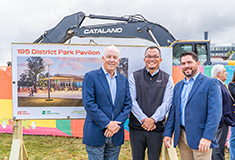News: Owners Developers & Managers
Posted: October 2, 2014
Resiliency is the new normal - How do we move towards more resilient thinking?
The data is undeniable - climate change is already happening. Although the cause is still being debated, we in the building community have to accept and plan for it.
On September 4-5, the Urban Land Institute's (ULI) "Building a Resilient City: Risks and Opportunities" Conference in San Francisco brought together over 350 planners, architects, engineers, land owners, business owners, and regulatory officials to address this very complex topic.
Those in attendance generally agreed that resiliency wasn't on their radar until Superstorm Sandy. Sandy taught us that "emergency responsiveness" is not enough, especially now that natural disasters have become more frequent and more damaging. Regions must be prepared to "bounce forward" - building (or rebuilding) in a proactive manner that prepares for climate change impacts - instead of just "bouncing back" - a response that often evades constructive critical thinking by focusing on bringing back normalcy as quickly as possible without planning for the future. We need to act - but act smart.
If we're going to "Bounce Forward," we need to fully implement the practices that we've begun to grasp over the past several years:
* Build a water culture. A surplus or lack of water is a common element in many natural disasters. By understanding how water can be managed most effectively, we can be better prepared when natural disasters occur.
* Strive for risk reduction, not perfect protection. Seeking perfect protection allows us a false sense of security, while seeking to reduce risk keeps us, as planners, prepared for future events.
* Use our collective intelligence and work together.
* Engage regional thinking and encourage regional authority. A jurisdictional boundary such as a city/town/county line should not be the limit of one's thinking and responsibility.
* Develop innovative resilient strategies and contingencies that utilize community capacity, multi-lateral public support, and an ability to implement across time and using multiple investors.
These practices require a holistic approach with all stakeholders: business leaders, property owners, community leaders, governmental agencies, insurance providers, and utility providers. Everyone must be engaged and strive for the common good.
Most importantly, we must remember that there is no cookie cutter or cut-and-paste solution. Every region has different challenges: coastal New England must address sea-level rise, while inland areas must address flooding and the West must address droughts. A region's natural and fiscal resources, infrastructure network, and political landscapes all play into this.
With all that said, how do we move towards more resilient thinking? We start by embracing today's reality, engaging in the discussion, learning from one another, and taking action. Our challenges are many and staying engaged is one our greatest challenges; human nature often allows us to trick ourselves into thinking that these storm events won't happen again. We cannot lose focus. Resiliency must be our "New Normal."
John Schmid, PE, LEED AP BD+C, is executive project manager, associate and member of the board of directors at Nitsch Engineering, Boston, Mass.
MORE FROM Owners Developers & Managers


Quick Hits

STAY CONNECTED
SIGN-UP FOR NEREJ EMAILS

Columns and Thought Leadership

Shawmut Design and Construction breaks ground on the 195 District Park Pavilion in Providence, RI
Providence, RI Shawmut Design and Construction celebrated the ceremonial groundbreaking for the 195 District Park Pavilion, marking the start of construction on a facility that will feature year-round dining and support space for park operations. In addition to the 3,500 s/f building, the project will include infrastructure upgrades

The New England Real Estate Journal presents
the First Annual Project of the Year Award! Vote today!
The New England Real Estate proud to showcase the remarkable projects that have graced the cover and center spread of NEREJ this year, all made possible by the collaboration of outstanding project teams. Now, it's time to recognize the top project of 2024, and we need your vote!

Investing in a falling rate environment - by Harrison Klein
Long-term interest rates have fallen by 100 basis points, and the market is normalizing. In December of 2022 I wrote an article about investing in a high interest rate, high inflation market. Since then, inflation has cooled off, and the Fed has begun lowering their funds rate.

The 2024 CRE markets: “The Ups” (industrial) and “The Downs” (Boston class B/C office) - by Webster Collins
The industrial markets have never been stronger. What has happened is that the build out of Devens with new high-tech biotech manufacturing with housing to service these buildings serves as the connector required to really make the I-495 West market sizzle. Worcester has been the beneficiary


